Virulent but not avirulent Mycobacterium tuberculosis can evade the growth inhibitory action of a T helper 1-dependent, nitric oxide Synthase 2-independent defense in mice
- PMID: 12370260
- PMCID: PMC2194026
- DOI: 10.1084/jem.20021186
Virulent but not avirulent Mycobacterium tuberculosis can evade the growth inhibitory action of a T helper 1-dependent, nitric oxide Synthase 2-independent defense in mice
Abstract
Control of infection with virulent Mycobacterium tuberculosis (Mtb) in mice is dependent on the generation of T helper (Th)1-mediated immunity that serves, via secretion of interferon (IFN)-gamma and other cytokines, to upregulate the antimycobacterial function of macrophages of which the synthesis of inducible nitric oxide synthase (NOS)2 is an essential event. As a means to understanding the basis of Mtb virulence, the ability of gene-deleted mice incapable of making NOS2 (NOS2(-/-)), gp91(Phox) subunit of the respiratory burst NADPH-oxidase complex (Phox(-/-)), or either enzyme (NOS2/Phox(-/-)), to control airborne infection with the avirulent R1Rv and H37Ra strains of Mtb was compared with their ability control infection with the virulent H37Rv strain. NOS2(-/-), Phox(-/-), and NOS2/Phox(-/-) mice showed no deficiency in ability to control infection with either strain of avirulent Mtb. By contrast, NOS2(-/-) mice, but not Phox(-/-) mice, were incapable of controlling H37Rv infection and died early from neutrophil-dominated lung pathology. Control of infection with avirulent, as well as virulent Mtb, depended on the synthesis of IFN-gamma, and was associated with a substantial increase in the synthesis in the lungs of mRNA for IFN-gamma and NOS2, and with production of NOS2 by macrophages at sites of infection. The results indicate that virulent, but not avirulent, Mtb can overcome the growth inhibitory action of a Th1-dependent, NOS2-independent mechanism of defense.
Figures
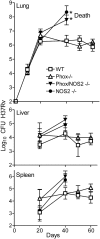
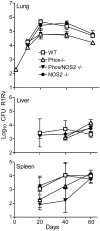
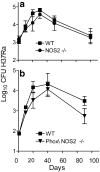
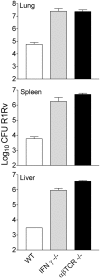
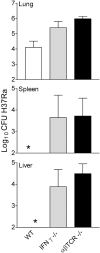
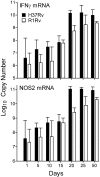

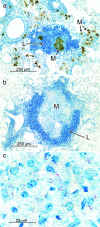
References
-
- Boom, W.H. 1996. The role of T cell subsets in Mycobacterium tuberculosis infection. Infect. Agents Dis. 5:73–81. - PubMed
-
- Cooper, A.M., B.M. Saunders, C.D. D'Souza, A.A. Frank, and I.M. Orme. 1997. Bull Inst. Pasteur. 95:85–95.
-
- Flynn, J.L., and J. Chan. 2001. Immunology of tuberculosis. Annu. Rev. Immunol. 19:93–129. - PubMed
-
- Raupach, B., and S.H. Kaufmann. 2001. Immune response to intracellular bacteria. Curr. Opin. Immunol. 13:417–428. - PubMed
Publication types
MeSH terms
Substances
Grants and funding
LinkOut - more resources
Full Text Sources
Molecular Biology Databases
Research Materials

